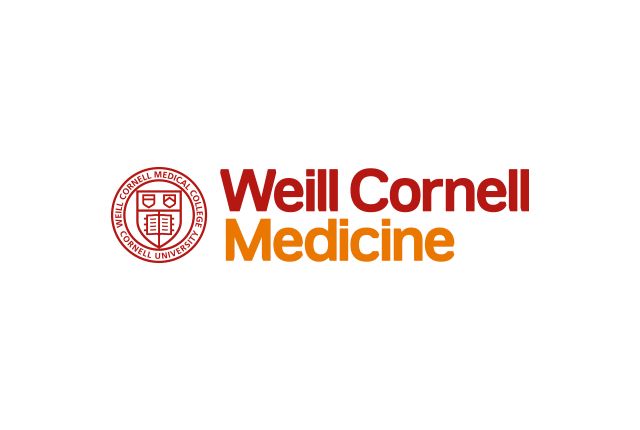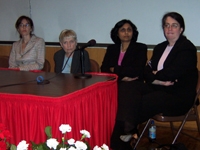Dr. Alexander Swistel, director of the Center and associate professor of clinical surgery, moderated the discussion, emphasizing the breadth and depth of talent at the Medical College - from radiologists to breast surgeons to radiation oncologists to reconstructive surgeons, all poised at the frontier of breast health. The many developments on the horizon are heralding a new era that holds promise for a cure, Dr. Swistel said.
Gladys Rosenthal, genetic counselor, opened with the good news that breast cancer is becoming a manageable disease. Geneticists have pegged the gene mutation (BRCA1) responsible for a predisposition to breast cancer, passed on in certain families, which compromises the gene's ability to suppress tumors. BRCA mutations are more likely to occur in women of Ashkenazi Jewish heritage, with ovarian cancer and with early-onset breast cancer. "Genetic testing has implications for all family members," she said.
Dr. Mia Talmor, assistant professor of plastic surgery, spoke of breakthrough techniques in breast reconstruction, with smaller incisions and skin-sparing techniques yielding more cosmetically acceptable results. Rates of recurrence and disease-free survival are all equivalent to the traditional breast cancer surgery. In a close collaboration, the oncologic surgeon and reconstructive surgeon work jointly before, during, and after operations.
Dr. Michele Drotman, assistant professor of radiology, discussed improved technologies in breast imaging. Mammography remains the best imaging tool to search for calcifications and masses; it's the standard method of screening on an annual basis for women over 40. Digital imaging, displayed and stored electronically, have improved mammography much as digital pictures have advanced traditional photography, with advantages in the speed of visualization, manipulation of images and magnification. More sensitive mammograms and ultrasounds allow for the detection of tumors when they're smaller and less advanced - making breast cancer easier to treat and aiding breast surgery.
Dr. Eleni Tousimis, assistant professor of surgery, discussed advances in surgical techniques, calling attention to the radical evolution over the past 100 years, from when mastectomy was the only option, to the breast conservation therapy that enables sentinel lymph node biopsy, lumpectomy, partial breast irradiation, and tumor ablation - the future of non-invasive breast cancer surgery. The Hospital, always at the cutting edge, has made among the first attempts in medicine to destroy tumors with minimally invasive techniques, such as killing tumors through freezing and heating techniques.
Dr. Ellen Gold, assistant professor of medicine, discussed updates in medical oncology. She emphasized the need for radiation therapy even after the tumor has been extracted with surgery, to prevent recurrence. This preventative therapy, called adjuvant therapy, is given after curative therapy to improve the chance of a cure. Hormonal therapy is an effective approach, since a receptor on the breast cancer cell is stimulated by estrogen to grow. Therefore, blocked estrogen production leads to regression of advanced tumors. The traditional breast cancer drug, tamoxifen, blocks the estrogen receptor and is the only drug that's FDA-approved. But in addition to or instead of tamoxifen, a new class of drug - aromatase inhibitors, which decrease the estrogen produced by the body in post-menopausal women - is being studied for its therapeutic potential. But drugs alone are only supplements, not substitutes, for radiation therapy, said Dr. Gold.
The next advancement in radiation therapy involves irradiating part of the breast, rather than the whole. Dr. Akkama Ravi, assistant professor of radiation oncology, spoke about new techniques that concentrate irradiation to the tumor area and away from the normal tissue. Weill Cornell is one of the country's leading sites in this new course of therapy. Potential benefits of partial breast irradiation include decreased downtime, cost and inconvenience, with more targeted results. But there are strict selection criteria. Suitable patients are those with minimal risk of multicentric disease, with the cancerous cells at single and isolated sites, and with tumors with low probability of extension. New techniques do concentrate irradiation to the tumor area and away from the normal tissue - with Weill Cornell, as always, at the forefront of investigation.
The evening closed on a note that placed breast health in a historical and cultural context, broadening the symposium's horizons. Roxanne Almond, a cultural historian, discussed the significance and impact of a late-19th-century painting of a mastectomy in progress by Thomas Eakins, America's foremost realist painter. "The developments in breast care covered tonight did not spring up like topseed, with no heritage or foundation," Almond said. "From where we've been, we've learned where we are going."
Photo by Melissa Hantman.


